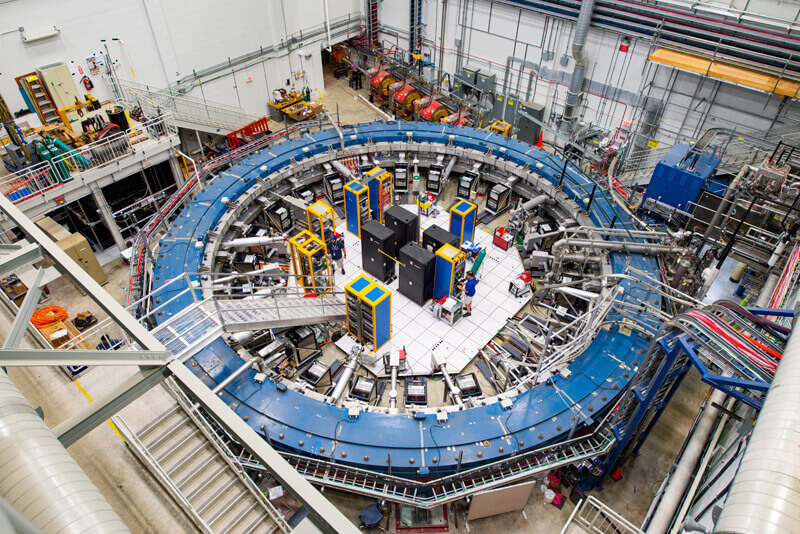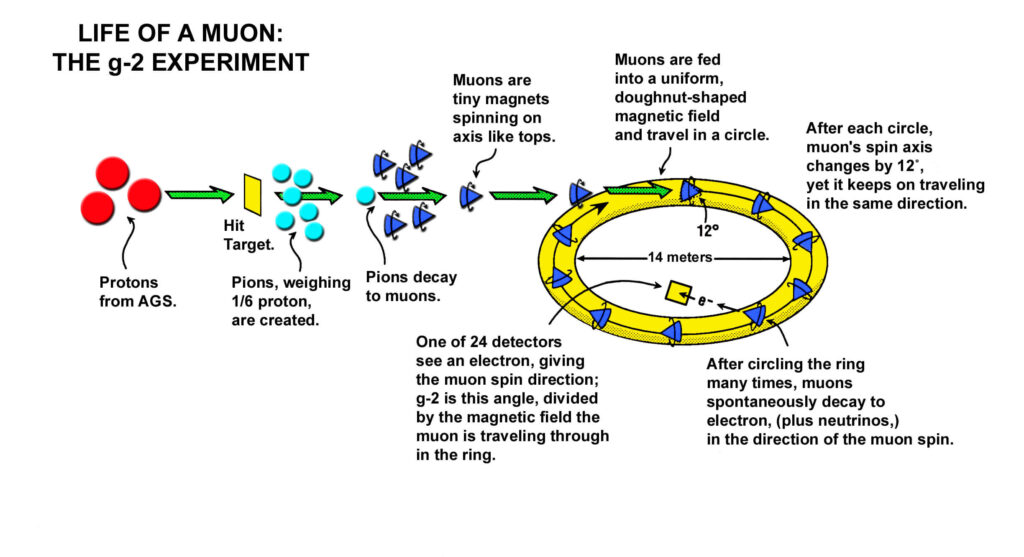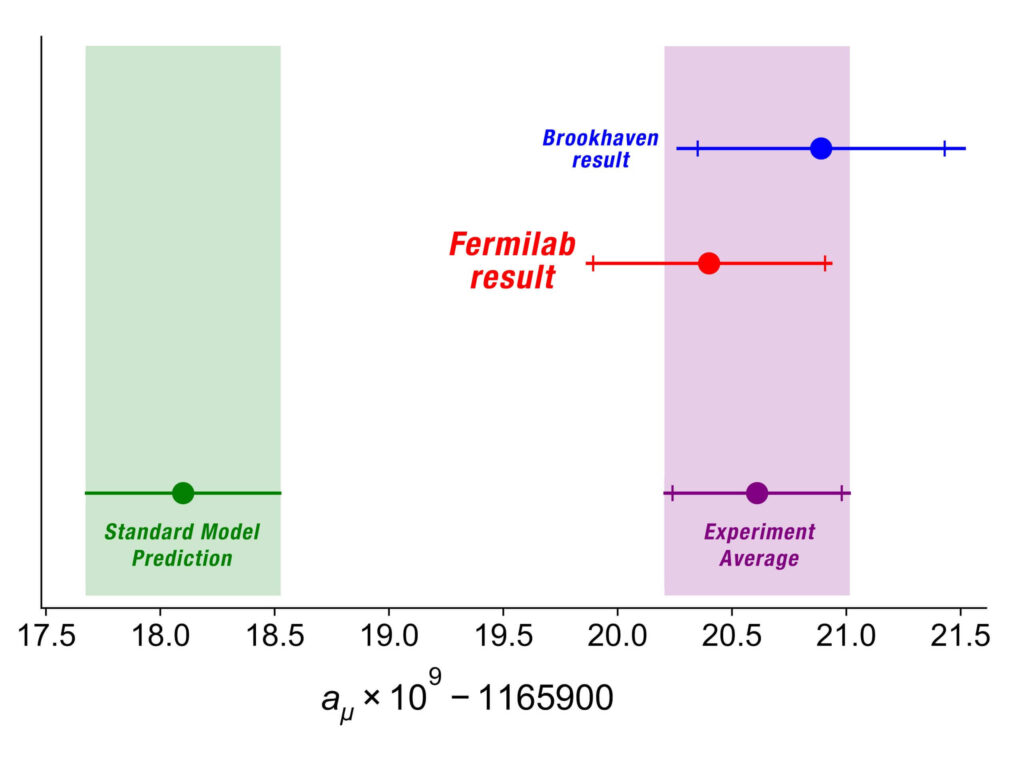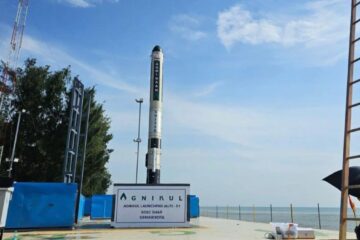Results of the Muon g-2 (pronounced “gee minus two”) experiment at Fermilab, a popular international experiment in the field of particle physics, were published recently on April 7, 2021, in the journal Physical Review Letters. The groundbreaking results of the experiment have shown the telltale signs of exciting new physics. The current experiment provided a more precise value of the magnetic dipole moment of the muon in comparison to the Muon g-2 experiment performed at Brookhaven National Laboratory, concluded in 2001.
Table of Contents
Standard Model of Particle Physics
All the known elementary particles and three of the four fundamental forces are encapsulated in a theoretical model called the Standard Model of Particle Physics. The finalized version of the standard model came into the picture in the 1970s. Since then the standard model has been updated thrice – (1) the top quark (1995), (2) the tau neutrino (2000), and (3) the Higgs boson (2012).

The current finding of the Muon g-2 experiment at Fermilab signals another update in the Standard Model of Particle Physics.
What is Muon?
The muon, represented with a Greek letter mu (μ), is an elementary particle in the Standard Model. Muons were discovered while studying cosmic radiation by Carl D. Anderson and Seth Neddermeyer at Caltech in 1936. A muon is similar to an electron in terms of an electric charge of −1e and a spin of 1/2. The difference between the mass of these elementary particles is very large, a muon is around 207 times heavier than an electron. In an electric field, muons accelerate more slowly than electrons due to higher mass. Muons are classified under Leptons just like electrons and are unstable subatomic particles with a mean lifetime of 2.2 μs. The g-factor of a charged lepton (electron, muon, or tau) is very nearly 2. For electron, the theoretical value and practical value of the g-factor are in agreement but the Muon g-2 Experiment at Fermilab proves that the same is not true with muons.
The g-factor is a dimensionless quantity that is a ratio of magnetic moment and spin angular momentum. The g-factor is also called the dimensionless magnetic moment.

Muon g-2 Experiment at CERN
The first experiment for the Muon g-2 Experiment was conducted in 1959 at CERN, the European Organization for Nuclear Research that houses the largest particle physics laboratory in the world. The basic aim of the experiment was to test quantum electrodynamics (QED) which deals with the behavior of charged subatomic particles under the influence of an electromagnetic force. While measuring the effect of quantum electrodynamics scientists observed a high-value magnetic moment of the muon.
The muon acts like a spinning magnet, its gyration and magnetic strength are measured using g-factor. Upon experiment, the value of the g-factor was found to be greater than 2. This anomaly in the value of the g-factor (g – 2) indicates a missing piece in the standard model. The experiment was done using a magnet of dimensions 83cm x 52cm x 10cm.
For a more precise value, a bigger magnet was used in Synchro-Cyclotron in 1960. First direct measurements of g-2 were published with a precision of 2% comparing to the theoretical value. The precision gradually reduced to just 0.4% in 1962 and the experiment was halted for some time.
The second attempt of the experiment was done in the year 1966 on the Proton-Synchrotron accelerator. This time the results were 25 times more precise than the earlier ones.
The third experiment was started in 1969 with a more strong setup for which the results were published in 1979 and confirmed the theory to a precision of 0.0007%.
In 1984 the US took up the investigation of the anomalous magnetic moment of the muon in Brookhaven National Laboratory.
You May Like To Read–
- Standard Model of Particle Physics – Explained
- What is Matter? – Definition and Characteristics
- Fundamental States of Matter – why there are so many states of matter?
Muon g-2 Experiment at Brookhaven National Laboratory

The experiment at Brookhaven National Laboratory (BNL) was constructed between 1989 to 1996 and the data for the same was calculated from 1997 to 2001. These experiments were done in Alternating Gradient Synchrotron, a particle accelerator at BNL, to provide a much more uniform magnetic field. The first result of calculating the anomalous magnetic moment of the muon from BNL was published on February 8, 2001, which predicted the difference between the theoretical value and experimental value of g-2.
The updated results released on July 30, 2002, from BNL were twice as precise compared to the earlier results. It should be noted that the results till now are only for the positively charged muons. Finally, on January 8, 2004, for the first time, precise measurements of how negatively charged muons behave in a magnetic field were published. It was found that when the positive and negative muon results are merged, from the direct theory calculation the result differs by 2.7 standard deviations, and from the indirect theory calculation, it differs by 1.4 standard deviations. This significant disagreement was a strong signal of a new physics that might complete the standard model.
Muon g-2 Experiment at Fermilab
Fermi National Accelerator Laboratory (Fermilab) acquired the equipment from Brookhaven National Laboratory after 10 years since its experiment ended in 2001. The scientists had been working for all these years to calculate more precise results for gnawing discrepancy of muon gee minus two. The same magnet used in the experiment at Brookhaven National Laboratory was refurbished and powered in order to generate a highly uniform magnetic field. The three data-taking periods (Run-1, Run-2, and Run-3) have been performed, with Run-4 currently open-ended. The results from the analysis of the Run-1 data were announced and published on April 7, 2021. The results are in agreement with and prove the 2001 experiment result of Brookhaven National Laboratory. The results of Muon g-2 Experiment at fermilab are shown in the table below with uncertainty in parentheses.
| Accepted theoretical values | New experimental values | |
|---|---|---|
| g-factor | 2.00233183620(86) | 2.00233184122(82) |
| Anomalous Magnetic Moment | 0.00116591810(43) | 0.00116592061(41) |

The combined results from Fermilab and Brookhaven show a difference with theory at a significance of 4.2 σ (sigma), a little less than 5 σ (or standard deviations) that scientists require to claim a discovery. These results are in a statistical fluctuation of about 1 in 40,000 but 4.2 sigma is a significant indicator of a new physics.
Current Events From Science And Technology–
- Nora Al Matrooshi – First Arab Woman Astronaut
- NASA’s Chandra X-ray Observatory detected X-rays from Uranus
- Carnivac-Cov: First COVID-19 Vaccine For Animals
- Polarized Image of Black Hole
Conclusion
The Muon g-2 scientific collaboration at Fermilab consists of 200 scientists from 35 institutions in seven countries. The calculated g-2 values are among the most precisely known quantities in physics to date. With the first result from the Fermilab experiment, only 6% of data has been analyzed and the data processing of further periods is going on. If the future results are in consensus with the first result of Muon g-2 Experiment at Fermilab and make the 5 sigma deviation then this will open the new doors for some new physics, especially low mass physics that otherwise can not be detected by the Large Hadron Collider particle accelerator.



0 Comments